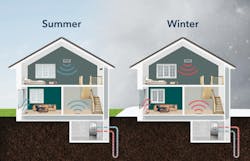Google spinoff uses pay-as-you-go business model to spur growth in geothermal systems
Geothermal systems can be potent tools to make heating and cooling more efficient, but the initial cost to install them is a giant barrier to adoption.
A spinoff from Alphabet, Google’s parent, that is backed by Bill Gates's Breakthrough Energy Ventures and Alphabet’s venture arm, is using a familiar financing method to breach that obstruction. Dandelion Energy is turning to a pay-as-you-go plan similar to rooftop solar panel leasing to help homeowners afford geothermal heat pump systems.
The company has installed heat pumps in more than 1,000 homes, with plans to double that number next year by offering the leasing model.
The company is also shaving costs from the geothermal installation process by using drilling practices that use geological data to more precisely deduce the optimal depth for each drilling operation.
This cost savings can be passed on to customers. The Inflation Reduction Act, which was passed by Congress and signed into law by President Joe Biden this year, increases federal tax credits for geothermal energy. That funding of incentives is expected to fuel growth for geothermal projects.
